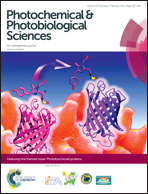Fast and effective inactivation of Bacillus atrophaeus endospores using light-activated derivatives of vitamin B2
Abstract
Highly resistant endospores may cause severe problems in medicine as well as in the food and packaging industries. We found that bacterial endospores can be inactivated quickly with reactive oxygen species (ROS) that were generated by a new generation of flavin photosensitizers. Flavins like the natural compound vitamin B2 are already known to produce ROS but they show a poor antimicrobial photodynamic killing efficacy due to the lack of positive charges. Therefore we synthesized new flavin photosensitizers that have one (FLASH-01a) or eight (FLASH-07a) positive charges and can hence attach to the negatively charged surface of endospores. In this study we used standardized Bacillus atrophaeus endospores (ATCC 9372) as a biological surrogate model for a proof-of-concept study of photodynamic inactivation experiments using FLASH-01a and FLASH-07a. After incubation of spores with different flavin concentrations, the flavin derivatives were excited with blue light at a light dose of 70 J cm−2. The inactivation of spores was investigated either in suspension or after attachment to polyethylene terephthalate (PET) surfaces. Incubation of spores suspended in Millipore water with 4 mM FLASH-01a for 10 seconds and irradiation with blue light for 10 seconds caused a biologically relevant decrease of spore survival of 3.5 log10 orders. Using FLASH-07a under the same conditions we achieved a decrease of 4.4 log10 orders. Immobilized spores on PET surfaces were efficiently killed with 7.0 log10 orders using 8 mM FLASH-07a. The total treatment time (incubation + irradiation) was as short as 20 seconds. The results of this study show evidence that endospores can be fastly and effectively inactivated with new generations of flavin photosensitizers that may be useful for industrial or medical applications in the future.


 Please wait while we load your content...
Please wait while we load your content...